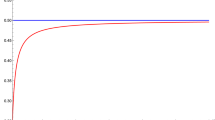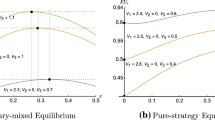Abstract
We characterize the equilibrium effort function of a large Tullock contest game with heterogeneous agents under mild conditions on the contest success function and effort cost function. Later, writing the equilibrium total effort explicitly under a uniform type distribution, we identify the effort-maximizing large Tullock contest. It is shown that the contest designer needs to increase the curvature of the effective effort function, thereby encouraging high-type agents to exert even higher efforts, as the curvature of the effort cost function increases or the support of the type distribution gets narrower.

Similar content being viewed by others
Notes
See Skaperdas (1996) for an axiomatic foundation of Tullock contests.
Note that if effective effort function is strictly concave, the same implication trivally follows.
If \(\lim _{x \rightarrow \infty } H(x) \rightarrow \infty\), any agent of type t has a finite best response to any effort profile X. However, as shown in the current proof, such an assumption is not needed for the existence of an equilibrium effort profile.
In fact, we conducted our numerical analysis for a larger set of parameter values and observed that the results we report here are robust in that larger set. We choose to not report all for space limitations and reader friendliness.
The reader can also observe in Fig. 1 the aforementioned result that for \(a_0 = 0\) and \(\theta >1\), the optimal \(\gamma ^*\) is at the middle point between 1 and \(\theta\).
References
Acemoglu D, Jensen MK (2013) Aggregate comparative statics. Games Econom Behav 81:27–49
Corchón LC (2007) The theory of contests: a survey. Rev Econ Design 11:69–100
Çağlayan D, Karagözoğlu E, Keskin K, Sağlam Ç (2022) Effort comparisons for a class of four-player tournaments. Soc Choice Welfare 59:119–137
Dasgupta A, Nti KO (1998) Designing an optimal contest. Eur J Polit Econ 14:587–603
Franke J, Kanzow C, Leininger W, Schwartz A (2013) Effort maximization in asymmetric contest games with heterogeneous contestants. Econ Theor 52:589–630
Gradwohl R, Kalai E (2021) Large games: robustness and stability. Ann Rev Econ 13:1–18
Konrad KA (2009) Strategy and dynamics in contests. Oxford University Press, New York
Lahkar R, Mukherjee S (2022) Optimal large population Tullock contests. Working Paper
Lahkar R, Sultana R (2022) Affirmative action in large population contests. Working Paper
Moldovanu B, Sela A (2001) The optimal allocation of prizes in contests. Am Econ Rev 91:542–558
Nti KO (2004) Maximum efforts in contests with asymmetric valuations. Eur J Polit Econ 20:1059–1066
Olszewski W, Siegel R (2016) Large contests. Econometrica 84:835–854
Olszewski W, Siegel R (2020) Performance-maximizing large contests. Theor Econ 15:57–88
Schmalensee R (1981) Output and welfare implications of monopolistic third-degree price discrimination. Am Econ Rev 71:242–247
Skaperdas S (1996) Contest success functions. Econ Theor 7:283–290
Szymanski S (2003) The economic design of sporting contests. J Econ Literat 41:1137–1187
Tullock G (1980) Efficient rent seeking. Buchanan JM, Tollison RD, Tullock G (eds) Toward a theory of the rent-seeking society. Texas A &M University Press, pp 97–112
Wang Z (2010) The optimal accuracy level in asymmetric contests. B.E. J Theor Econ 10:Article 13
Acknowledgements
We would like to thank an anonymous reviewer for helpful comments and suggestions.
Author information
Authors and Affiliations
Corresponding author
Additional information
Publisher's Note
Springer Nature remains neutral with regard to jurisdictional claims in published maps and institutional affiliations.
Rights and permissions
Springer Nature or its licensor (e.g. a society or other partner) holds exclusive rights to this article under a publishing agreement with the author(s) or other rightsholder(s); author self-archiving of the accepted manuscript version of this article is solely governed by the terms of such publishing agreement and applicable law.
About this article
Cite this article
Doğan, S., Karagözoğlu, E., Keskin, K. et al. Large Tullock contests. J Econ 140, 169–179 (2023). https://doi.org/10.1007/s00712-023-00829-8
Received:
Accepted:
Published:
Issue Date:
DOI: https://doi.org/10.1007/s00712-023-00829-8




